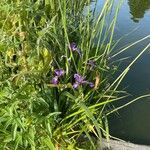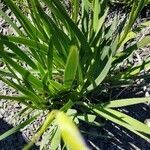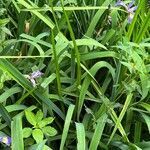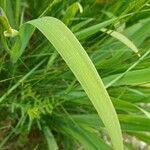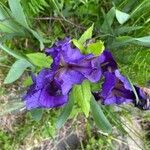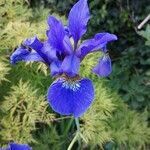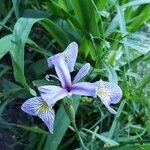Rhizomes pale pinkish white, freely branching, forming large clumps, 1–2.5 cm diam., clothed with remnants of old leaves; roots fleshy. Stems 1–2-branched, solid, 2–6 dm. Leaves: basal with blade green to grayish green, often purplish basally, centrally thickened in mature leaves, prominently veined, narrowly ensiform, 1–8 dm × 1–3 cm; cauline 1–2, blade linear-lanceolate, seldom equaling stem. Inflorescences compact, units 2–4-flowered; spathes never foliaceous, 3–6 cm, unequal, outer shorter than inner, thickly chartaceous to scarious, margins shiny, darker in color. Flowers: perianth violet-blue to rarely white; floral tube funnelform, constricted above ovary, 1–1.2 cm; sepals ovate to reniform, 4–7.2 × 1.8–4 cm, base abruptly attenuate, signal a pubescent, greenish or greenish yellow patch surrounded by heavily veined purple on white at base of blade; petals lanceolate to oblong-lanceolate, 2–5 × 0.5–2 cm, much shorter than sepals, firm, apex rarely emarginate; ovary rounded-triangular in cross section, somewhat inflated, 0.8–2 cm; style 3–3.5 cm, base not auriculate, margins entire or toothed, crests reflexed, 0.7–1.5 cm; stigmas unlobed, triangular or rounded-triangular, margins entire; pedicel 2–8 cm, frequently exceeding spathe. Capsules often persistent over winter, ovoid to oblong-ellipsoid, conspicuously beaked, obtusely triangular in cross section, 1.5–6 cm, tardily dehiscent. Seeds dark brown, D-shaped, 5–8 mm, shiny, thin, hard, regularly pebbled, not corky. 2n = 108.
More
Lvs broadly linear to ensiform, erect or arching from thick creeping rhizomes and forming large clumps, stems 2–8 dm, equaling or usually slightly exceeding the lvs; bracts with vernicose dark margins; fls on short pedicels, 6–8 cm wide, violet or blue-violet to red-purple, lavender, or rarely white; sep spreading, unspotted or with a minutely papillate, greenish-yellow blotch at the base of the blade surrounded by white variegations and purple veins, the veins extending into the claw; pet erect, half to two-thirds as long as the sep, the claw pale-streaked; ovary 1–2 cm at anthesis; fr bluntly 3-angled, prismatic-cylindric, 3.5–5.5 cm, indehiscent; seeds with a ± regularly pebbled surface; 2n mostly = 108; perhaps an allopolyploid derived from nos. 8 [Iris virginica L.] and 10 [Iris setosa Link]. Marshes, swamps, meadows, and shores; Nf. and Lab. to Man., s. to Va. and Minn. May–July (Aug.)
Can be grown by divisions or seedlings. Seeds needs stratification.
